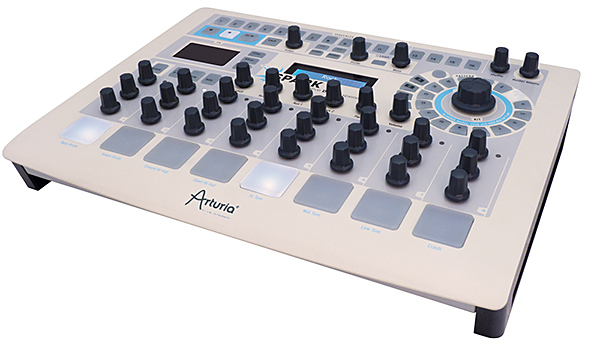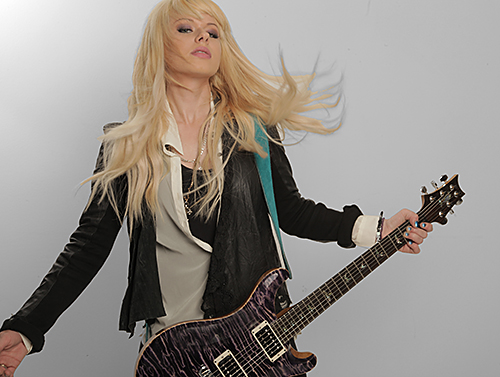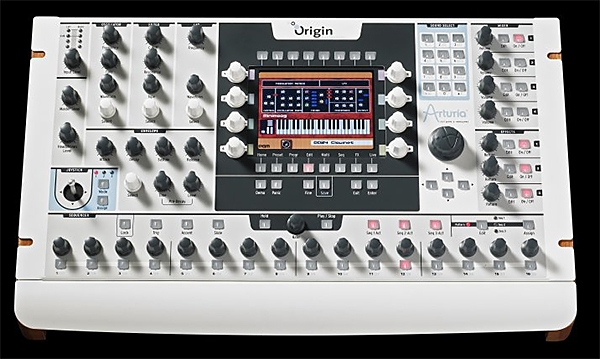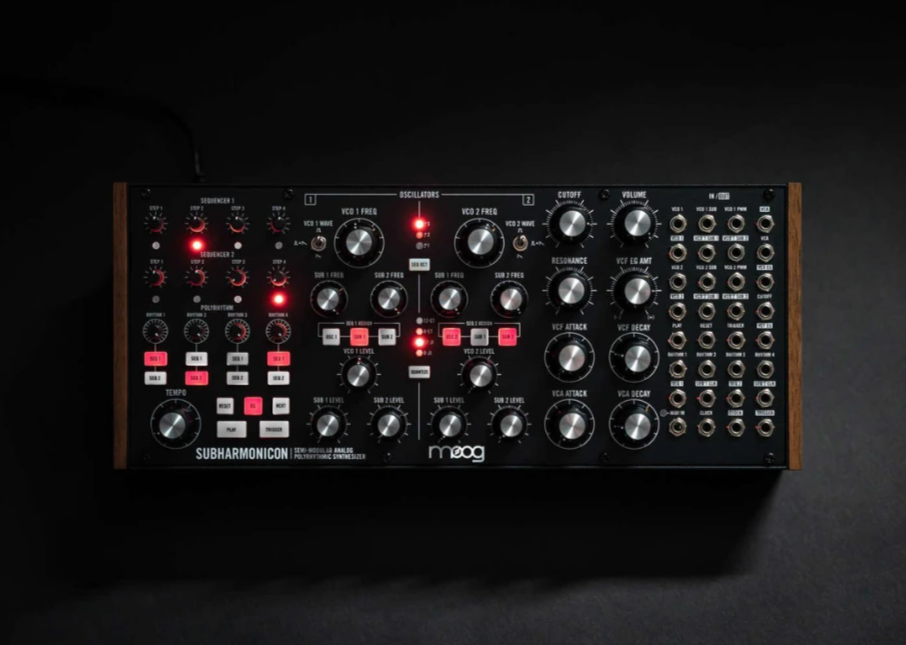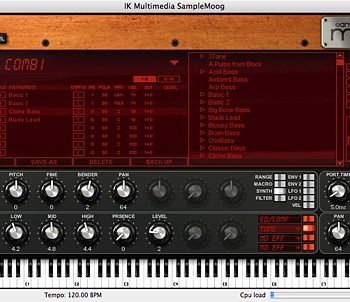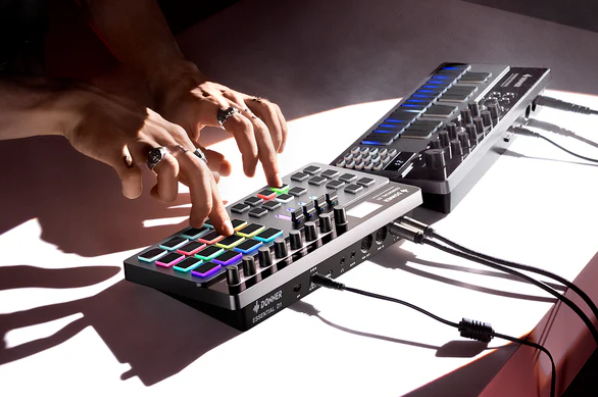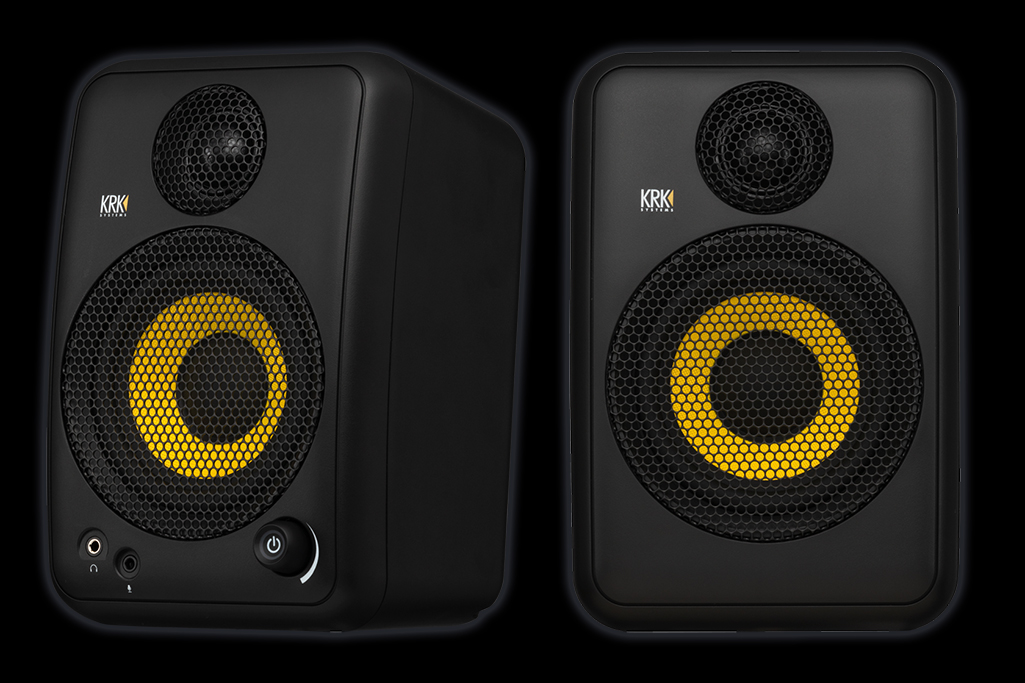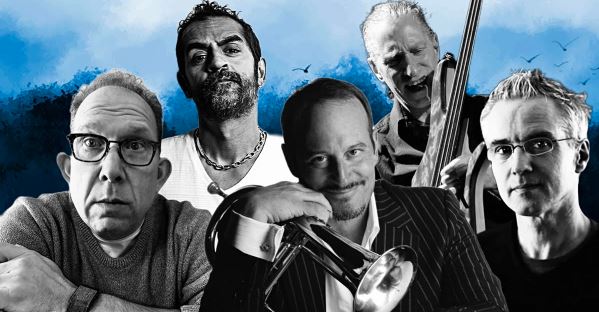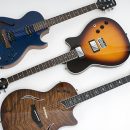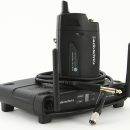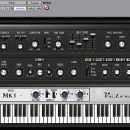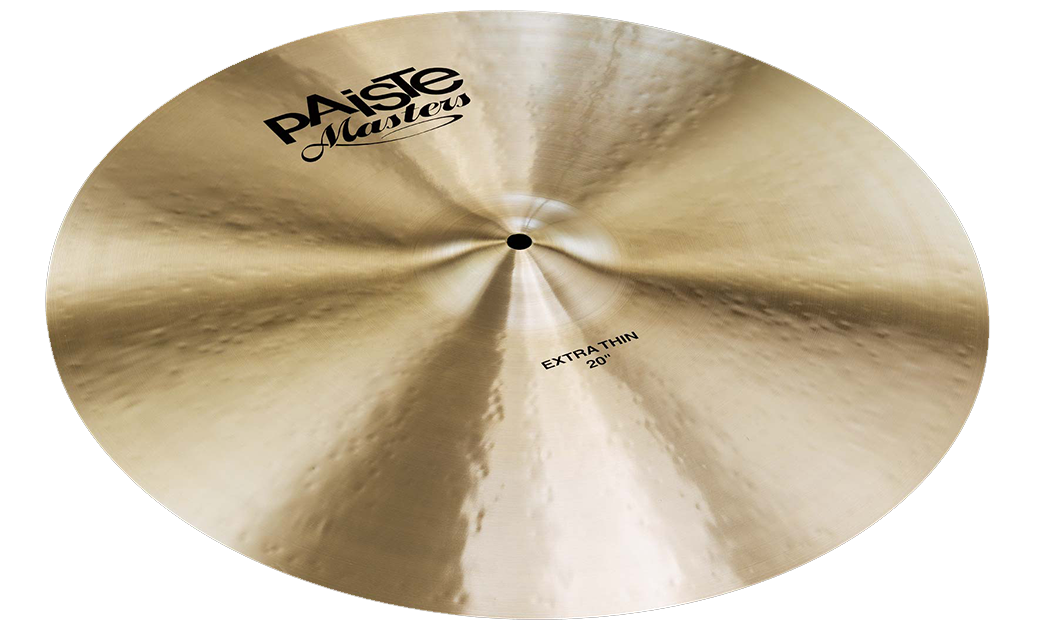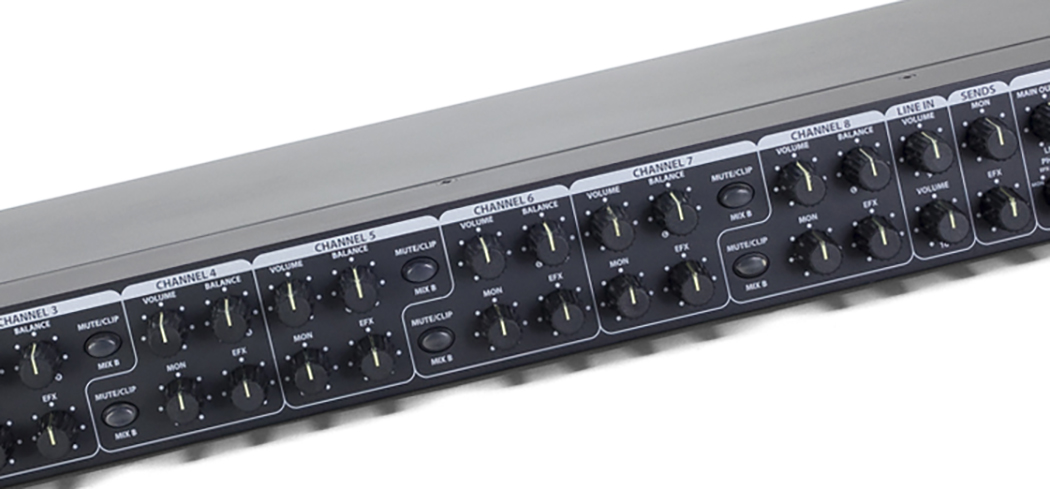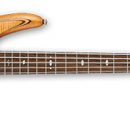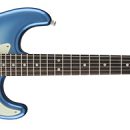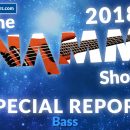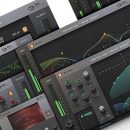 We love cool soft-synths, make no mistake. However, there is always something to be said about real hardware that you can touch, tweak, and interact with. While soft-synths are certainly here to stay, one thing we enjoyed seeing at the 2013 Winter NAMM Show was a resurgence of hardware-based instruments.
We love cool soft-synths, make no mistake. However, there is always something to be said about real hardware that you can touch, tweak, and interact with. While soft-synths are certainly here to stay, one thing we enjoyed seeing at the 2013 Winter NAMM Show was a resurgence of hardware-based instruments.
Arturia, well known for its great soft-synth emulations of classic hardware, has now released the latest version of its hybrid (software/hardware) drum machine, Spark. First released in 2010, Spark has undergone several revisions, each one adding feature improvements, bug fixes, more drum kits, and more ways to modify your sounds. Combining analog synthesis, physical modeling, and samples, Spark allows for a great variety of sonic possibilities. Your favorite classic drum machines are all here, and the latest version of the Spark software adds some neat tricks, including the Oberheim filter from the SEM soft-synth.
| Category | Value | Rating | ||||
| Features | 20% |
|
||||
| Usability | 25% |
|
||||
| Sound | 25% |
|
||||
| Documentation & Support |
10% |
|
||||
| Price | 20% |
|
||||
|
|
||||||
| OVERALL RATINGS: Spark = 3.6, which earns it a WIHO Award! Spark LE = 3.7, which earns it a WIHO Award! 3.6 stars or better: Outstanding, WIHO Award 3 stars or better: Worth considering 2 stars or better: Suited to specific needs 1 star or less: Not recommended |
||||||
Spark is a great product, and it has continued to get better with each software revision. Even better, Spark comes with a software "MIDI Control Center," enabling you to use the controller with just about any sound source, but obviously targeting drum software.
In the continuing trend of "smaller is better" and miniaturization of, well, just about everything these days, Arturia has also recently released the compact SparkLE. Don't let the name fool you, though. There's nothing "lite" about the LE—except the weight. SparkLE uses the exact same software as the original Spark. The only difference is the controller itself, which is obviously smaller. It's a curious idea, given the original was not too big or bulky, to begin with. But if you want a full-featured software and hardware package, both products are great. You can't go wrong with either, but if you want to save several hundred dollars and could be well served by a smaller controller, the SparkLE, in particular, is a really good deal.
Features
Spark and SparkLE consist of a hardware controller and software you install on your computer. Available for both Mac and PC, you will need at least 2GB of RAM and at least a 2GHz Intel computer, running Mac OS X 10.5 or later, or Windows XP/Vista/7. Some of the included features, as per Arturia's website, are:
- Multiple sound engines including TAE analog synthesis, physical modeling, and multi-layered samples
- 1,620 instruments, 110 kits (extended in the new 1.5 library) comprised of: Vintage drum machine emulations: TR-808, TR-909, TR-606, Simmons SDS-V, Linn Drum, Drumtraks, DMX, Drumulator
- Ten new emulations: CR-78, Mini Pops 7, Ace Tone FR-2L, Yamaha MR 10, Maestro Rhythm King MRK2, Boss DR-55, E-mu-SP-12, Roland DR-727, Roland R-8, Casio VL-Tone and SK-1
- Electronic kits for styles including: EDM, Dubstep, Hip Hop, RnB, Pop
- Acoustic drum kits mixing physical modeling and samples
- Sixteen key, 64-step sequencer
- Eight velocity- and pressure-sensitive pads (SparkLE’s are smaller)
- Touch-sensitive FX pad with Repeat, Tape, Reverse, Strobe, Pan, Mix, Bit Crusher, three-mode Filter, and Roller
- Sixteen-channel mixer with fourteen effects: multi-band compressor, bit crusher, multiband EQ, chorus, delay, reverb, distortion, phaser, plate reverb, destroyer, flanger, space pan, limiter, sub generator
- Oberheim filter
- MIDI clock output to synchronize your hardware instruments

The aluminum-clad Spark hardware controller is both solid and easily portable.
The top part of Spark consists of sixteen buttons representing sixteen steps of the sequencer, which actually allows for up to 64 steps of beat programming. At the bottom are eight pads, conveniently labeled as bass drum, snare, etc. (though you can assign other sounds to them). Each pad has three knobs above it, which allow for modifying various sound parameters. These come pre-assigned (i.e., tone, decay, pitch, noise mix) but may also be reassigned to other parameters. The velocity-sensitive pads themselves have a nice feel and allow for fast movement to program patterns. Furthermore, they are sensitive enough to allow for the nuances of your performance. Sampled sounds can have up to six layers triggered by each pad.
In the middle of the controller lies the LCD screen to give you information, and to the left of that are a few more controls, including a very cool "FX" pad. Essentially an X-Y controller, this provides real-time access to Filter (i.e., low/high-pass), Slicer (which lets you move patterns around), and Roller (generates repeated notes at varying rates) parameters, but again, these can be changed to other effects, such as reverse or echo. The Loop button allows you to temporarily shorten a loop and create unusual fills, for example, when a loop is already playing in real time.
To the right of the LCD is the jog dial, a large knob to select drum kits, instruments, and sixteen buttons surrounding it to select patterns. Spark uses a maximum of 64 steps in a pattern, 64 patterns in a Song, and 64 patterns in a Project as well. Patterns can be as simple or as complex as you need, while a song is a sequence of patterns placed in order. You can freely switch between song and pattern playback at any time, to add a little variety to your rhythms.
Spark utilizes four banks of sixteen patterns each to access up to sixty-four patterns. When a new pattern is selected, you have the choice of whether your beat switches immediately or after the last step in the currently playing pattern is reached. During playback, the tracer light indicates progress along the row of sequencer steps. Select any drum and you can view and modify its active steps.
Speaking of tracer lights, all the functions/pads are lit up, so Spark is easy to see in low light situations. This makes it especially useful for concert settings, and we applaud Arturia for designing Spark this way. The 16-step buttons have scrolling lights that move in accordance to what step you are on, and the other buttons are lit so you can see what you are doing in dimly lit clubs, for example. The SparkLE is a smaller, more portable version of Spark.software
The SparkLE is a smaller, more portable version of Spark.software
First things first: the software is exactly the same. The only difference is the controller itself. While we hardly see the need for a more compact Spark, the SparkLE will certainly take up much less travel space, fitting into the front compartment of most backpacks. If you want to play drums atop Mt. Everest, this could be just the ticket.
 Of course, the controller is only part of what Spark/SparkLE is about. The sound engine of Spark is contained in the software. A few screenshots on the side.
Of course, the controller is only part of what Spark/SparkLE is about. The sound engine of Spark is contained in the software. A few screenshots on the side.
The software once started, displays an exact duplicate of the hardware controller on the screen. If your hardware controller is connected, the screen gives you a message saying as such, and you are on your way. As shown above, there are other screens available. The library view shows the sounds that are available, and a nice feature is the ability to import your own samples. You may import WAV, AIFF, REX loops, and MIDI files. You can even drag and drop right into your DAW, a very rare but useful feature.
Another screen featured in Spark is the 16-track mixer, with two auxiliary effects. Each drum has its own channel, plus two insert effects with nine possible effect choices. They include what you would expect: compressor, bit crusher, EQ, chorus, delay, reverb, etc. If you prefer to use your own plug-in effects, there's a multi-output mode to re-route individual voices to up to sixteen stereo channels.
Two other screens are the Instrument screen, which lets you get into the fine tuning of each instrument (volume, panning, resonance, cutoff) and the Song Mode screen which allows you to chain patterns together for song arrangement.
Usability
We ran Spark on our Mac Pro eight-core, 8GB system, both in standalone mode and within Pro Tools LE. Installation and product registration was easy without any problems. Well, almost no problems.We had to install version 1.5 a second time, as the first time, for some reason, the RTAS plug-in didn't install properly and Pro Tools couldn't see it. After the second time running the installer, all was well. Many will be happy to know that there is no iLok or dongle needed: just a serial number and unlock code to authorize and you're done. However, version 1.5 was not our final install, as the latest release, 1.6.1.1 at the time of this writing, proved significantly more stable than the first version we installed. Assuming you start with the latest release, you should be just fine.
At first we were a little daunted by all the functionality of Spark, and a few times in the beginning we found ourselves asking, "How do I do that?" But the more we used Spark, the more its layout made sense, and we came to enjoy working with it after we got past the initial learning curve. In fact, the more we used it, the more we wanted to use it. Our initial questions were then replaced by, "Oh, that sounds cool!"
We do wish there was a way to break up the single scrolling window into multiple windows you can panel, but that's a minor nag. We found that Spark has a great feel, a great sound, and having briefly used version 1.1.3 before upgrading for this review, we can honestly say the folks at Arturia are listening to their users and making big strides to really make Spark the best it can be.
While most features were accessible via the controller, we still needed to use our mouse on the computer to take complete advantage of the product. For example, while it is possible to activate/deactivate recording quantization from the hardware (select+record button), there is no quantization tool on the controller to lock up your recorded performance. While not a big deal, it would be nice to be able to manipulate everything from the controller than the computer, but then again, this is a hybrid hardware/software solution, so perhaps that is to be expected.
Spark uses what is called Projects, and each Project contains a kit with various patterns/styles to be used as s starting point for, well, your project. Each kit consists of sixteen drums derived from either modeling or actual samples. You can select and choose these using the big Arturia knob on the right side of the controller. While some of these patterns may be a little over the top and busy for some tastes, the actual sounds themselves are great. Since you can choose from acoustic samples, synth kits, and very good emulations of classic machines (to our ears) from Simmons, Roland, Oberheim, and LinnDrum, you've got a great palette for your canvas.
Above each pad on the Spark (representing a drum kit sound, of course) are three knobs to adjust parameters; the SparkLE has all the pads but only one set of three knobs, which are toggled between pads. We didn’t feel this was a major omission as most of the time we only wanted to tweak one drum sound at a time anyway. These functions vary for what drum you are controlling. For example, an acoustic drum may assign these knobs to attack and decay, while a synth tom may have other parameters. As there are only eight pads, and typically sixteen drum sounds comprising a kit, each controller has a dedicated button to toggle between sounds 1-8 and 9-16.
The pad themselves are sensitive (in a good way!), feel sturdy, and give good tactile feedback. No need to worry about giving them a good thump. While your DAW will recognize the Spark and SparkLE controllers, your DAW acts as the master to Spark, to which your patterns are synced. Alternatively, patterns (.WAV or .MID files) can be exported or even dragged from the Spark software into you DAW song.
The FX pad certainly deserves mention. Located on the left side of the controller, this is sort of like Arturia’s version of Roland’s D-beam or Alchemy’s real time control section. This enabled us to manipulate assigned parameters in real-time on an X-Y grid. For example, the FX pad can be assigned to a low pass filter, and while a pattern is playing, you can move your finger across the pad in any direction you like and hear your swirling effects in real time. Using the mouse on the screen, you can click on the Filter button near the graphic version of the FX pad, and change, for example, to a high pass filter. The movements of your finger are seen graphically on the screen. This is just the tip of the iceberg, as those who are creative will find lots of fun things to assign the FX pad for some interesting sound design.
There is a Library section as part of the controller software, and this is where you can import and export sounds and patterns. We found it a little busy and confusing at first, but again, once we became more familiar with the interface it proved straightforward. You have the ability to import REX loops, so if you have invested in that format you will be quite happy.
The Mixer section, a button-click away from the Library section, offers something your ‘80s beat box couldn’t do by itself, nor with the computers of the time (with all due respect to the Apple //e, of course): a full featured, sixteen-channel mixer with auxiliary effects, effects sends, and high quality effects. Who doesn’t like a bit crusher every now and then? A nice touch was the ability to re-route the mixer to other plug-in effects from our DAW.

The obvious differences you’ll notice between the Spark and SparkLE hardware controllers are smaller pads and fewer knobs. However, Arturia was quite clever and efficient with their design, and in some ways, we actually prefer the design of the SparkLE better! Sometimes less is more, and to some degree that is the case with the LE controller. There are a few more dedicated buttons on the SparkLE that were not present on the original Spark—like Copy, Pattern, Kit, and Instrument.
On Spark, the large Arturia knob is used to scroll through different modes to get to what you want, whereas on the LE, there are dedicated buttons to toggle between modes. Either method is pretty easy, but for many players, a labeled button makes things a bit easier.
The pads themselves are smaller, but certainly big enough to be comfortable. And their feel seemed pretty comparable to Spark, which was already very good. Happily, the FX pad was still present, and appeared to be the same size as the original, although (interestingly) not labeled as FX like on the original. However, the LCD screen from Spark is absent on SparkLE. We had to look at our computer screen more often while using SparkLE than with Spark. As these were designed to be hardware/software hybrids, some computer reliance was expected, so to us this wasn’t a big deal overall.
Spark can be used as a MIDI controller for other (drum) programs, though we didn’t spent too much time testing this functionality. When you hold down the Filter, Slicer, and Roller buttons simultaneously, that puts Spark and SparkLE in Controller mode, which appears on the Spark LED screen when activated (or on an LED on the SparkLE, which lacks the LED screen). You can then use the MIDI port (separate from the USB port, which is reserved for interacting with the Spark software) to control your drum software. Since everything is assignable, you get a lot of ways to control your program(s), whether operating other drum plug-ins or triggering samples.
It was a nice touch allowing for multiple uses of the Spark controller. We did find this, however, a little buggy in earlier versions of the software, which made our Pro Tools session crash more than a few times. Thankfully, this latest version, 1.6.1.1 proved leaps and bounds better in the stability department, and we didn’t experience a single crash after installing the latest software.
For those who want a little more on-screen help, in the software main panels, you can activate a Verbose mode by clicking the small [?] button on the top left corner of the panel. It displayed additional information including the secondary functions of some of the controller knobs/buttons. This proved useful as we were getting to know the hardware.
Sound
The sounds themselves are excellent, and for those who remember and/or used the classic drum machines of the past, you won’t be disappointed. Since there are both sampled and modeled sounds, you can get everything from basic acoustic sounds to tricked out, funky, bizarre sounds.
We loved the inclusion of low-fi, 8-bit sounds, and the Casiotone kits brought us down memory lane. However, there are plenty of modern sounds in here too. And, Arturia is adding expansion packs all the time, including the recent Dubstep expansion pack. While many of the patterns are great for getting you started, you can easily make your own patterns, and even mix and match kit pieces from any era. How cool is that? Anyone looking for a modern beat box that can “do it all” should take serious consideration of Spark.
While all the individual sounds were high-quality sounding across the board, and the emulations of classic Roland machines were very convincing in particular, we did enjoy some of the custom kits even more. The kit Block Party had a great Depeche Mode ‘80s vibe, and we also liked the aggressiveness of Astral Alliance. We also liked some of the grittiness of the later kits, including the DR-700 and -800 series.
Documentation and Product Support
Spark and SparkLE each includes a printed manual, which as particularly nice, as these days so many manuals are only provided in PDF form. However, as our base-install version of Spark happened to be released prior to version 1.6.1.1, all the latest updates for version 1.6.1.1 were, in fact, online in PDF form. Arturia's website has plenty of information and useful videos for getting started and introducing features. Since SparkLE is a newer product, the printed manual was even more up-to-date.
Price
Arturia Spark (MSRP $599) sells for $499 street. It is a versatile drum workstation that can sound as classic or modern as you want, and it works great in live settings. With good presets/patterns, great sounds, in-depth editing (with a little practice), and a useful MIDI controller mode, Spark should find a place in many studios.
SparkLE (MRSP $299, street $249) is a smaller hardware controller that bridges the gap between the full Spark hardware and the plug-ins for musicians on a tighter budget. However, given that the software is exactly the same for both versions, you still get a great controller in the LE version that doesn’t feel very scaled down for $200 less. The Spark controller is obviously bigger with more knobs physically present, but the LE has all the same functionality and sound in a smaller footprint, and in some ways allows for a more streamlined workflow. You really can’t go wrong with either one. It’s just a matter of taste.
If you’re just after the sounds of classic drum machines and a virtual interface suits you fine, sub-collections of Spark software are available for just $99 apiece. You can’t get the entire software collection separately, but many styles/collections are available.
Contact Information
Arturia
www.arturia.com
| Evaluation Short-List |
|

